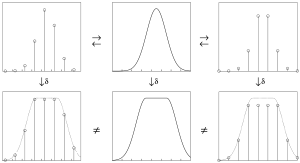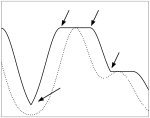Precise image-based measurement
through irregular sampling
Here I copy a few relevant sections from the VR project proposal that was
funded.
Principal Investigator: Cris Luengo.
Co-PI: Matthew Thurley.
Problem Statement

Figure 1: Discrete dilations on a sampled function do not
produce results comparable to the equivalent continuous-domain operation on
the function before sampling. Furthermore, changing the sampling grid will
change the result of the discrete operation.
[Figure taken from Luengo Hendriks & Vliet (2003).]
Operations within mathematical morphology depend strongly on the sampling grid
(Luengo Hendriks & van Vliet, 2003), and therefore always produce a result different
from what would be obtained by the corresponding continuous-domain operation.
However, measurements derived from a sampled image should correspond to measurements
of the object being imaged. That is, image-based measurements are ideally sampling
invariant. For example, see Figure 1: a shift of the sampling grid changes
the result of the dilation; a linear filter would have produced a sampled version
of the same continuous-domain function in both cases. There are three reasons why
the morphological operators are not sampling invariant:

Figure 2: Smooth, band-limited function (dotted line) and its
dilation. Arrows indicate the points where the derivative is not continuous
(indicating the function is not band-limited).
- The output is given by the supremum or infimum (maximum or minimum) value in
a neighbourhood. But it is very likely that a local extremum falls in between
sampling grid points (as happens in the example of Figure 1), and therefore the
discrete operator produces a different value than the continuous-domain operator
would.
- The operators produce lines along which the derivative is not continuous
(see Figure 2). These discontinuities introduce infinitely high
frequencies, making the result not band limited; therefore, the result cannot
be represented using the classical sampling theorem.
- The structuring element is a set, and thus in the discrete case, the
image is probed with a shape limited by the sampling grid. On a rectangular
sampling grid it is impossible to define a rotationally invariant set.
We propose to tackle these three issues by stepping away from the classical
sampling theory. Instead, we will use irregular sampling in such a way that
local maxima and minima are always sampled, and increasing the sampling density
in areas with a non-continuous derivative. At the same time, it should be
possible to reduce the sampling density in plateaus (flat areas), also commonly
produced by these operators.
The watershed transform (Vincent and Soille, 1991) is a very commonly used
algorithm to segment an image. It divides the image into regions separated by
ridges of high grey values. The classical watershed algorithm selects a set of
pixels as boundaries between regions. Some other implementations assign all
pixels to one of the regions, making the segmentation boundary run in between
pixels. In either case, the boundary between regions is given by integer grid
coordinates, even though the ridges in the image can be located with much
higher precision. Determining these region boundaries with a higher precision
would improve many measurement tasks.
Significance
The intersection proposed here between classical mathematical morphology
on a discrete grid and the continuous-domain information provided by
band-limited, sampled images, is not studied at all in the literature
(besides a few papers published published by the applicants). Nonetheless,
this combination has the potential to yield image measurement tools with
significantly increased precision over existing tools. Image-based
measurement is very common, and becoming more important. Mathematical
morphology with increased precision is applicable everywhere where better
precision or more efficient algorithms are required. The two applications
discussed in the plan are good test beds for the methods to be developed,
but represent only a fraction of the possible applications. Other results
of applying these algorithms could be, for example:
- a better chance at differentiating healthy from pre-cancerous cells
in a Pap smear;
- reduced tolerance in nanofabrication, as certain tools might be
controlled more precisely;
- increased data acquisition speed and reduced memory requirements
for aerial mapping; or
- improved localization in SLAM (simultaneous localization and mapping).
Previous Work
Brockett and Maragos (1994) proposed PDEs to compute the continuous-domain
dilation and erosion in the discrete domain. Many authors since have improved
on these PDEs and their implementations. However, these methods still yield a
worse approximation to the continuous-domain operators than the discrete
operators. The main reason for this is that the result of the morphological
operators is not band limited, and therefore cannot be represented on a
regular grid. The more iterations are needed to solve the PDE, the more the
result deviates from the expected result. Furthermore, these methods are very
slow. These two flaws together make morphological PDEs not useful in practice.
Thurley (2002; Thurley and Ng, 2005) proposed morphological operators for
irregularly sampled 3D surface data that used continuous-domain structuring
elements. This allowed analysis without resampling to a regular grid nor
interpolating to fill holes. These operators shifted sample points along the
z axis only. (See the "Preliminary results" section for more details.)
Luengo (Luengo Hendriks and van Vliet, 2005; Luengo Hendriks et al., 2007)
proposed operations that are, strictly speaking, not morphological operators,
but their results approximate continuous-domain morphology better than the
true discrete operators, and, consequently, can be used to perform more
accurate measurements. These operations, besides a few other tricks, rely on
interpolation to improve their result. (See the "Preliminary results" section
for more details.)
We have not been able to identify other work relating the discrete and
continuous-domain morphological operators.
Preliminary results
Some time ago Luengo worked on increasing the precision and accuracy of one
commonly used measurement tool from mathematical morphology: the granulometry
(Luengo Hendriks et al., 2007). The granulometry is a multi-scale operation
that yields a size distribution of objects, or of one of the phases of a
multi-phase material. By ignoring strict compliance to the properties of the
granulometry in the discrete grid, he was able to create a discrete operation
that better approximates the properties of its continuous-domain counterpart,
in particular the scale sampling and rotation invariance. He modified the way
that the structuring element is defined, and used interpolation to further
improve the results at small scales.
In the same vein, Luengo has proposed to implement dilations and erosions
with lines under arbitrary orientation using interpolation (Luengo Hendriks
and van Vliet, 2005). This implementation again provides results much closer
to its continuous-domain counterpart, at the expense of strict compliance to
properties of the discrete operation.
Finally, Luengo Hendriks and van Vliet (2003) presented continuous-domain
implementations of the basic morphological operators for a sampled,
one-dimensional, band-limited function. Here, Luengo created a piecewise
polynomial representation of the sampled function, and transformed these
polynomials to obtain the result of the morphological operators. However, this
seemed a dead end, as extending this to higher dimensions would be prohibitive.
Thurley (2002; Thurley and Ng, 2005) defined morphological operators
(dilation and erosion, their compositions, as well as more complex tools such
as reconstruction by dilation and the watershed segmentation) for irregularly
sampled 3D surface points. The operators used the z coordinate (height) as
the intensity value; the x and y position of the samples was not changed by
these operators. This allowed analysis of scanned rock piles without
resampling to a regular grid nor interpolating to fill holes. However,
structuring element decomposition, an often used property of the elemental
morphological operators, whilst still practically applicable, was not
strictly satisfied.
In relation to this work, Thurley developed a prioritised interpolation
scheme using limitations of the surface topology (Landström et al., 2011),
which allows a better estimate of portions of the surface hidden from view of
the camera. That is, the holes in the data could be filled in more reliably.
References
R.W. Brockett, and P. Maragos (1994), Evolution equations for continuous-scale morphological filtering, IEEE Transactions on Signal Processing 42(12):3377-3386.
A. Landström, F. Nellros, H. Jonsson, and M. Thurley (2011), Image reconstruction by prioritized incremental normalized convolution, in: Image analysis, LNCS 6688:176-185, Springer.
C.L. Luengo Hendriks, G.M.P. van Kempen, and L.J. van Vliet (2007), Improving the accuracy of isotropic granulometries, Pattern Recognition Letters 28(7):865-872.
C.L. Luengo Hendriks, and L.J. van Vliet (2003), Basic morphological operations, band-limited images and sampling, in: Scale Space Methods in Computer Vision, LNCS 2695:313-324, Springer.
C.L. Luengo Hendriks, and L.J. van Vliet (2005), Using line segments as structuring elements for sampling-invariant measurements, IEEE Transactions on Pattern Analysis and Machine Intelligence 27(11): 1826-1831.
M. Thurley (2002), Three dimensional data analysis for the separation and sizing of laboratory rock piles, PhD Thesis, Monash University.
M. Thurley, and K.C. Ng (2005), Identifying, visualizing, and comparing regions in irregularly spaced 3D surface data, Computer Vision and Image Understanding 98(2):239-270.
L. Vincent, and P. Soille, Watersheds in digital spaces: an efficient algorithm based on immersion simulations, IEEE Transactions on Pattern Analysis and Machine Intelligence 13(6):583-598.

 © 2014 Cris Luengo
© 2014 Cris Luengo
Last modified November 26, 2014.

